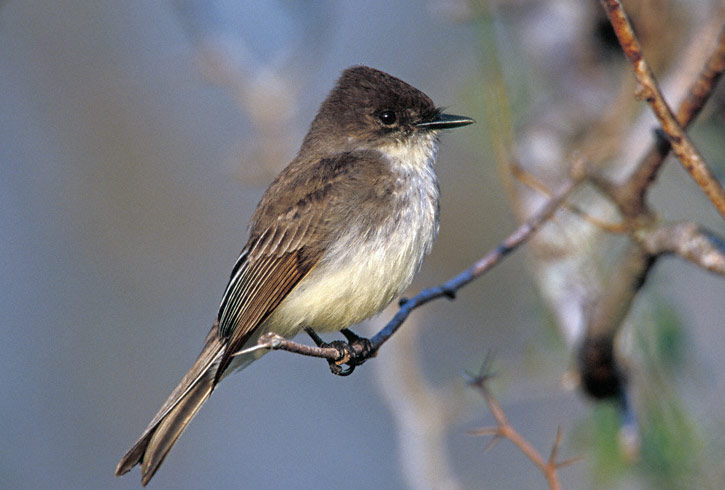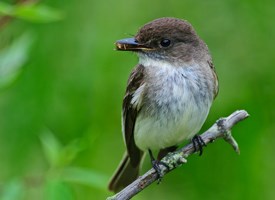
Sayornis phoebe
SUBFAMILY
Fluvicolinae
TAXONOMY
Sayornis phoebe Latham, 1879. Monotypic.
OTHER COMMON NAMES
French: Moucherolle phйbi; German: Phoebe; Spanish: Mosquero
Fibн.
PHYSICAL CHARACTERISTICS
7 in (18 cm). Plumage includes dark brownish gray head and
upperparts, dark brownish wings and tail, white underparts
(touched with yellow in fall in first-year birds), and olive-tinted
sides and breast. Bill is small and black, as are feet and legs.
DISTRIBUTION
Eastern North America from central Canada to the Midwest
and northeastern states; winters in the southern states and eastern
Mexico.
HABITAT
Lives near lakes and rivers in forest edges, open areas with
scattered trees, and rocky areas.
BEHAVIOR
Often wags tail on perch. Lives singly or in pairs. Songs include
a sharp, repeated “chip!” and a “FEE-be!” with an accent
on the first syllable.
FEEDING ECOLOGY AND DIET
Perches to watch for insects, catches prey in midair, and returns
to perch. Also takes insects from foliage and from the
ground. Sometimes takes fruit, berries, and small fish.
REPRODUCTIVE BIOLOGY
Breeds two to three times per year. Mostly monogamous, but
sometimes a male breeds with more than one female. Female
builds a cup-shaped nest attached to a vertical wall or on a
shelf. Nest may be located on a cliff, building, or bridge.
CONSERVATION STATUS
Not threatened by IUCN standards. Blue-listed by the National
Audubon Society in 1980 and listed as Special Concern
in 1986, due to decreases in several areas across the Midwest,
south Atlantic, and Great Lakes regions. Some populations
in the 1990s were reported to be stable or increasing, and
ranges of some populations were expanding, possibly due to
the species’ tolerance for human-made structures as nesting
sites.
SIGNIFICANCE TO HUMANS
Migrates early and indicates the coming of spring to the southern
states. The first bird-banding experiment in North America,
carried out by John James Audubon in 1840, used the
eastern phoebe to gather information about longevity, dispersal,
migratory movements, and site fidelity.
Photo Gallery of - Eastern phoebe




 Animalia Life
Animalia Life